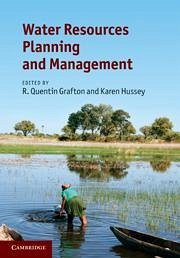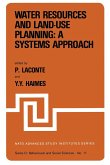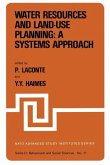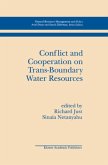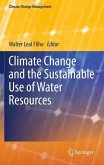Water Resources Planning and Management
Herausgeber: Grafton, R Quentin; Hussey, Karen
Water Resources Planning and Management
Herausgeber: Grafton, R Quentin; Hussey, Karen
- Gebundenes Buch
- Merkliste
- Auf die Merkliste
- Bewerten Bewerten
- Teilen
- Produkt teilen
- Produkterinnerung
- Produkterinnerung
The most comprehensive handbook ever published on water resource issues from a global perspective, for students, researchers and professionals.
Andere Kunden interessierten sich auch für
![The Economics of Groundwater Management in Arid Countries The Economics of Groundwater Management in Arid Countries]() Manuel SchifflerThe Economics of Groundwater Management in Arid Countries159,99 €
Manuel SchifflerThe Economics of Groundwater Management in Arid Countries159,99 €![Water Resources and Land-Use Planning: A Systems Approach Water Resources and Land-Use Planning: A Systems Approach]() P. Laconte / Y.Y. Haimes (Hgg.)Water Resources and Land-Use Planning: A Systems Approach112,99 €
P. Laconte / Y.Y. Haimes (Hgg.)Water Resources and Land-Use Planning: A Systems Approach112,99 €![Water Resources and Land-Use Planning: A Systems Approach Water Resources and Land-Use Planning: A Systems Approach]() Water Resources and Land-Use Planning: A Systems Approach42,99 €
Water Resources and Land-Use Planning: A Systems Approach42,99 €![Climate Change and the Sustainable Use of Water Resources Climate Change and the Sustainable Use of Water Resources]() Climate Change and the Sustainable Use of Water Resources162,99 €
Climate Change and the Sustainable Use of Water Resources162,99 €![Conflict and Cooperation on Trans-Boundary Water Resources Conflict and Cooperation on Trans-Boundary Water Resources]() Conflict and Cooperation on Trans-Boundary Water Resources121,99 €
Conflict and Cooperation on Trans-Boundary Water Resources121,99 €![Climate Change and the Sustainable Use of Water Resources Climate Change and the Sustainable Use of Water Resources]() Climate Change and the Sustainable Use of Water Resources162,99 €
Climate Change and the Sustainable Use of Water Resources162,99 €![Entropy, Water and Resources Entropy, Water and Resources]() Horst NiemesEntropy, Water and Resources81,99 €
Horst NiemesEntropy, Water and Resources81,99 €-
-
-
The most comprehensive handbook ever published on water resource issues from a global perspective, for students, researchers and professionals.
Hinweis: Dieser Artikel kann nur an eine deutsche Lieferadresse ausgeliefert werden.
Hinweis: Dieser Artikel kann nur an eine deutsche Lieferadresse ausgeliefert werden.
Produktdetails
- Produktdetails
- Verlag: Cambridge University Press
- Seitenzahl: 800
- Erscheinungstermin: 28. März 2011
- Englisch
- Abmessung: 253mm x 182mm x 40mm
- Gewicht: 1696g
- ISBN-13: 9780521762588
- ISBN-10: 0521762588
- Artikelnr.: 32203083
- Herstellerkennzeichnung
- Libri GmbH
- Europaallee 1
- 36244 Bad Hersfeld
- gpsr@libri.de
- Verlag: Cambridge University Press
- Seitenzahl: 800
- Erscheinungstermin: 28. März 2011
- Englisch
- Abmessung: 253mm x 182mm x 40mm
- Gewicht: 1696g
- ISBN-13: 9780521762588
- ISBN-10: 0521762588
- Artikelnr.: 32203083
- Herstellerkennzeichnung
- Libri GmbH
- Europaallee 1
- 36244 Bad Hersfeld
- gpsr@libri.de
List of contributors; Foreword; Preface; Acknowledgements; Introduction;
Part I. Understanding 'Water': 1. Climate change and the global water
cycle; 2. Understanding global hydrology; 3. Groundwater and surface water
connectivity; 4. Understanding the basics of water quality; 5. Inland water
ecosystems; 6. Water, biodiversity and ecosystems: reducing our impact; 7.
Global food production in a water constrained world: exploring 'green' and
'blue' challenges and solutions; Part II. Water Resources Planning and
Management: 8. Water law and the search for sustainability: a comparative
analysis; 9. Tackling the global water crisis: unlocking international law
as fundamental to the peaceful management of the world's shared
transboundary waters - introducing 'the H2O paradigm'; 10. Risk and
uncertainty in water resources planning and management: a basic
introduction; 11. Collaboration and stakeholder engagement; 12. Capacity
building and knowledge sharing; 13. Adaptive and integrated management of
water resources; 14. Gender and integrated water resource management; 15.
Environmental flows: achieving ecological outcomes in variable
environments; Part III. Water Resources Planning and Management - Case
Studies: Section 1. Water and Waste Water Treatment: 16. Overcoming water
scarcity in Perth, Western Australia; 17. Cities, agriculture and
environment - sharing water in and around Hyderabad, South India; 18.
Pricing of urban water services: the case of France; 19. Collaborative
flood and drought risk management in the Upper Iskar Basin, Bulgaria;
Section 2. Agricultural Water Use: 20. The role of research and development
in drought adaptation on the Colorado River Basin; 21. Climate change in
the Murray-Darling Basin: implications for water use and environmental
consequences; Section 3. Urban Water Supply and Management: 22. The urban
water challenge in Australian cities; 23. Water sensitive urban design; 24.
Water security for Adelaide, South Australia; Section 4. Aquatic
Ecosystems: 25. Groundwater contamination in Bangladesh; Section 5.
Industrial and Mining Water Use: 26. Water issues in Canada's tar sands;
27. Science, governance, and environmental impacts of mines in developing
countries: lessons from Ok Tedi in Papua New Guinea; Section 6. Rural and
Remote Communities: 28. Aboriginal access to water in Australia:
opportunities and constraints; 29. Providing for social equity in water
markets: the case for an indigenous reserve in northern Australia; Section
7. Water Infrastructure Design and Operation: 30. Flood hazard, floodplain
policy and flood management; Section 8. Managing Water Across Borders: 31.
Decision making in the Murray-Darling Basin; 32. Challenges to water
cooperation in the lower Jordan River Basin; 33. Adaptation and change in
Yellow River management; 34. Managing international river basins: successes
and failures of the Mekong River Commission; Section 9. Market Mechanisms
in Water Management: 35. Inter-sectoral water trading as a climate change
adaptation strategy; Contributors' biographies; Index.
Part I. Understanding 'Water': 1. Climate change and the global water
cycle; 2. Understanding global hydrology; 3. Groundwater and surface water
connectivity; 4. Understanding the basics of water quality; 5. Inland water
ecosystems; 6. Water, biodiversity and ecosystems: reducing our impact; 7.
Global food production in a water constrained world: exploring 'green' and
'blue' challenges and solutions; Part II. Water Resources Planning and
Management: 8. Water law and the search for sustainability: a comparative
analysis; 9. Tackling the global water crisis: unlocking international law
as fundamental to the peaceful management of the world's shared
transboundary waters - introducing 'the H2O paradigm'; 10. Risk and
uncertainty in water resources planning and management: a basic
introduction; 11. Collaboration and stakeholder engagement; 12. Capacity
building and knowledge sharing; 13. Adaptive and integrated management of
water resources; 14. Gender and integrated water resource management; 15.
Environmental flows: achieving ecological outcomes in variable
environments; Part III. Water Resources Planning and Management - Case
Studies: Section 1. Water and Waste Water Treatment: 16. Overcoming water
scarcity in Perth, Western Australia; 17. Cities, agriculture and
environment - sharing water in and around Hyderabad, South India; 18.
Pricing of urban water services: the case of France; 19. Collaborative
flood and drought risk management in the Upper Iskar Basin, Bulgaria;
Section 2. Agricultural Water Use: 20. The role of research and development
in drought adaptation on the Colorado River Basin; 21. Climate change in
the Murray-Darling Basin: implications for water use and environmental
consequences; Section 3. Urban Water Supply and Management: 22. The urban
water challenge in Australian cities; 23. Water sensitive urban design; 24.
Water security for Adelaide, South Australia; Section 4. Aquatic
Ecosystems: 25. Groundwater contamination in Bangladesh; Section 5.
Industrial and Mining Water Use: 26. Water issues in Canada's tar sands;
27. Science, governance, and environmental impacts of mines in developing
countries: lessons from Ok Tedi in Papua New Guinea; Section 6. Rural and
Remote Communities: 28. Aboriginal access to water in Australia:
opportunities and constraints; 29. Providing for social equity in water
markets: the case for an indigenous reserve in northern Australia; Section
7. Water Infrastructure Design and Operation: 30. Flood hazard, floodplain
policy and flood management; Section 8. Managing Water Across Borders: 31.
Decision making in the Murray-Darling Basin; 32. Challenges to water
cooperation in the lower Jordan River Basin; 33. Adaptation and change in
Yellow River management; 34. Managing international river basins: successes
and failures of the Mekong River Commission; Section 9. Market Mechanisms
in Water Management: 35. Inter-sectoral water trading as a climate change
adaptation strategy; Contributors' biographies; Index.
List of contributors; Foreword; Preface; Acknowledgements; Introduction;
Part I. Understanding 'Water': 1. Climate change and the global water
cycle; 2. Understanding global hydrology; 3. Groundwater and surface water
connectivity; 4. Understanding the basics of water quality; 5. Inland water
ecosystems; 6. Water, biodiversity and ecosystems: reducing our impact; 7.
Global food production in a water constrained world: exploring 'green' and
'blue' challenges and solutions; Part II. Water Resources Planning and
Management: 8. Water law and the search for sustainability: a comparative
analysis; 9. Tackling the global water crisis: unlocking international law
as fundamental to the peaceful management of the world's shared
transboundary waters - introducing 'the H2O paradigm'; 10. Risk and
uncertainty in water resources planning and management: a basic
introduction; 11. Collaboration and stakeholder engagement; 12. Capacity
building and knowledge sharing; 13. Adaptive and integrated management of
water resources; 14. Gender and integrated water resource management; 15.
Environmental flows: achieving ecological outcomes in variable
environments; Part III. Water Resources Planning and Management - Case
Studies: Section 1. Water and Waste Water Treatment: 16. Overcoming water
scarcity in Perth, Western Australia; 17. Cities, agriculture and
environment - sharing water in and around Hyderabad, South India; 18.
Pricing of urban water services: the case of France; 19. Collaborative
flood and drought risk management in the Upper Iskar Basin, Bulgaria;
Section 2. Agricultural Water Use: 20. The role of research and development
in drought adaptation on the Colorado River Basin; 21. Climate change in
the Murray-Darling Basin: implications for water use and environmental
consequences; Section 3. Urban Water Supply and Management: 22. The urban
water challenge in Australian cities; 23. Water sensitive urban design; 24.
Water security for Adelaide, South Australia; Section 4. Aquatic
Ecosystems: 25. Groundwater contamination in Bangladesh; Section 5.
Industrial and Mining Water Use: 26. Water issues in Canada's tar sands;
27. Science, governance, and environmental impacts of mines in developing
countries: lessons from Ok Tedi in Papua New Guinea; Section 6. Rural and
Remote Communities: 28. Aboriginal access to water in Australia:
opportunities and constraints; 29. Providing for social equity in water
markets: the case for an indigenous reserve in northern Australia; Section
7. Water Infrastructure Design and Operation: 30. Flood hazard, floodplain
policy and flood management; Section 8. Managing Water Across Borders: 31.
Decision making in the Murray-Darling Basin; 32. Challenges to water
cooperation in the lower Jordan River Basin; 33. Adaptation and change in
Yellow River management; 34. Managing international river basins: successes
and failures of the Mekong River Commission; Section 9. Market Mechanisms
in Water Management: 35. Inter-sectoral water trading as a climate change
adaptation strategy; Contributors' biographies; Index.
Part I. Understanding 'Water': 1. Climate change and the global water
cycle; 2. Understanding global hydrology; 3. Groundwater and surface water
connectivity; 4. Understanding the basics of water quality; 5. Inland water
ecosystems; 6. Water, biodiversity and ecosystems: reducing our impact; 7.
Global food production in a water constrained world: exploring 'green' and
'blue' challenges and solutions; Part II. Water Resources Planning and
Management: 8. Water law and the search for sustainability: a comparative
analysis; 9. Tackling the global water crisis: unlocking international law
as fundamental to the peaceful management of the world's shared
transboundary waters - introducing 'the H2O paradigm'; 10. Risk and
uncertainty in water resources planning and management: a basic
introduction; 11. Collaboration and stakeholder engagement; 12. Capacity
building and knowledge sharing; 13. Adaptive and integrated management of
water resources; 14. Gender and integrated water resource management; 15.
Environmental flows: achieving ecological outcomes in variable
environments; Part III. Water Resources Planning and Management - Case
Studies: Section 1. Water and Waste Water Treatment: 16. Overcoming water
scarcity in Perth, Western Australia; 17. Cities, agriculture and
environment - sharing water in and around Hyderabad, South India; 18.
Pricing of urban water services: the case of France; 19. Collaborative
flood and drought risk management in the Upper Iskar Basin, Bulgaria;
Section 2. Agricultural Water Use: 20. The role of research and development
in drought adaptation on the Colorado River Basin; 21. Climate change in
the Murray-Darling Basin: implications for water use and environmental
consequences; Section 3. Urban Water Supply and Management: 22. The urban
water challenge in Australian cities; 23. Water sensitive urban design; 24.
Water security for Adelaide, South Australia; Section 4. Aquatic
Ecosystems: 25. Groundwater contamination in Bangladesh; Section 5.
Industrial and Mining Water Use: 26. Water issues in Canada's tar sands;
27. Science, governance, and environmental impacts of mines in developing
countries: lessons from Ok Tedi in Papua New Guinea; Section 6. Rural and
Remote Communities: 28. Aboriginal access to water in Australia:
opportunities and constraints; 29. Providing for social equity in water
markets: the case for an indigenous reserve in northern Australia; Section
7. Water Infrastructure Design and Operation: 30. Flood hazard, floodplain
policy and flood management; Section 8. Managing Water Across Borders: 31.
Decision making in the Murray-Darling Basin; 32. Challenges to water
cooperation in the lower Jordan River Basin; 33. Adaptation and change in
Yellow River management; 34. Managing international river basins: successes
and failures of the Mekong River Commission; Section 9. Market Mechanisms
in Water Management: 35. Inter-sectoral water trading as a climate change
adaptation strategy; Contributors' biographies; Index.

